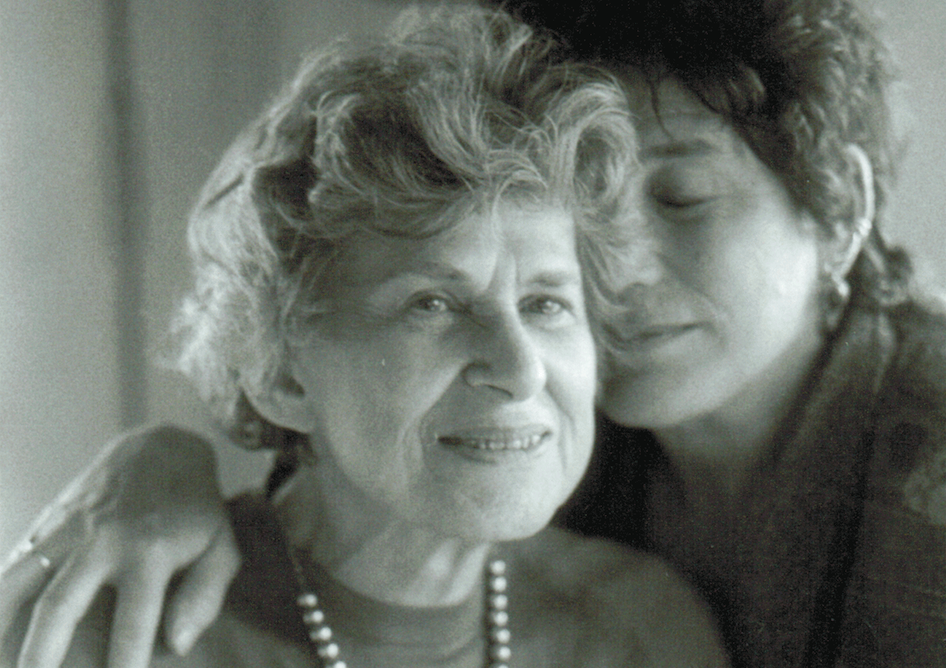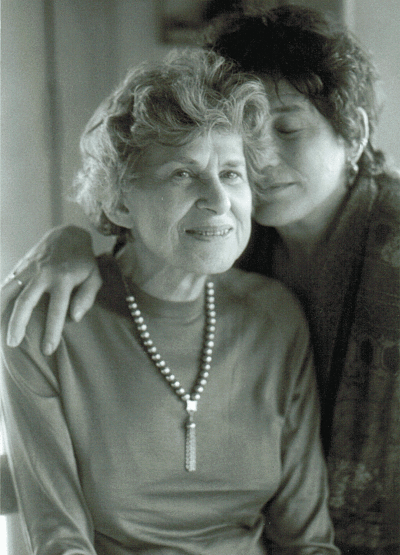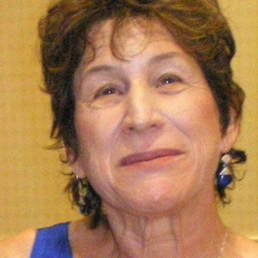Essay by Meryl Natchez
A Mother’s Day Tribute to Living on Your Own Terms

In the last years of her life, when my mother began forgetting things, one of the first she forgot was my father’s name. When I filled it in for her, she dismissed him with a wave of her hand. “He was a detour,” she said.
I couldn’t help feeling a little miffed that she could brush off almost thirty years of married life so easily and, by implication, my brothers and me. But in her vision of herself, her real life—the twenty-plus years she lived as a therapist on the twenty-first floor of an apartment building on West End Avenue in New York—began after she left my father. “My best decade was my fifties,” she often told me. Those were the years after she left her marriage, the suburbs, her job as a professor at City College of New York, and bought her apartment.
I have two photos of her then: In one, she’s wearing a flowing ethnic dress, her eyes sparkling; in the other, one my mother particularly loved, she's paragliding off a boat in Mexico. She had shrugged off the constraints of the 1950s, her children were grown, and she was a practicing psychotherapist and published author in a world of intellectuals. She'd been to Esalen and worked with Fritz Perls. She spoke at conferences. She had a hot tub installed in her apartment—bringing a little California ‘60s ambiance to the upper west side of New York.
My mother loved her practice and saw patients until she began forgetting their names and appointment times. Even after that, she was the best person to go to for a heart-to-heart talk about anything that mattered. I still follow her advice in times of trouble: “Don’t try to change it; breathe through it.”
In the early ‘90s, during the last few years of her life, she left the city she loved and moved to California to be near her grandchildren and me. For the most part, she was able to laugh at herself as her faculties eroded. When someone at her retirement complex got the idea of taking all the cards the residents received, cutting off the messages, and reusing the fronts, she asked my mother to help. My mother, who thought the idea absurd, serenely said, “I’d love to help, but I’m so unreliable”—then she told us the story, delighted with her response. When she and I were trying to recreate her favorite dessert recipe and wound up with the wrong number of cups of flour and a huge mess, we made jokes and laughed until we could hardly stand up.
But when she forgot how to write checks and began to write notes reminding herself of her notes, she decided it was time to die.
Many people say they don’t want to go on living in a diminished state, but somehow they never say, “Okay, today I’m ready to die.” By the time that day comes, it’s too late; they’ve lost the capacity to act. My mother was different.
She had mentioned being ready to die before, but I had simply listened, noncommittal. It was a topic I wouldn’t talk about unless she insisted. Although I could see her daily anxiety mounting as she became unable to navigate simple tasks, I really didn’t want to think about helping her die. I hated the whole idea of it. She was my mother. She had always been there for me, and I wanted her to go on being there. The idea of her absence was unbearable. Then there were the legal issues, the moral issues, my own fear of her increasing dependence, all of which made me wish the problem would somehow resolve itself without intervention. So I waited.
One evening, we were having dinner together at her retirement complex after I’d been away for a few weeks. It seemed like an ordinary meal. I’d brought over part of the chicken casserole I’d made for my family; I told her all about my trip to Dallas. But as I was starting to clear the plates, she asked me to sit back down.
“I don’t want to go on like this,” she said.
My mother, who could no longer read a book or follow the simplest TV plot, then eloquently explained to me that she had had a rich, fulfilling life. She had done everything she ever wanted to do, and looking ahead, she didn’t like what she saw. She felt less and less herself each day.
“I’m ready to go, but I need your help,” she said.
She kept pressing me, taking my hand, holding it. I didn’t see how I could say no. I knew if I were in her shoes, I’d feel the same. Still, I looked at the pachysandra and geraniums lining the windowsill, some with notes on their pots about when to water them. After a long moment, I hugged her. I finally nodded.

“Well then, Meryl.” Now she was all business. “What are we waiting for?” Patience had never been one of her virtues.
This was pre-Internet, so we got in my car and headed for Books Inc., our local bookstore, which was open until 11 p.m. We were looking for Final Exit, the Hemlock Society’s how-to book on ending your life. That night, we wandered the aisles just before closing, searching for the book but afraid to ask for help. When we found it and brought it to the cashier, I wondered if he’d let us buy it—a 78-year-old woman and her daughter—and then whether we were on camera and if the authorities would use this against me later. I was really scared, as if just thinking about suicide were illegal.
But despite my misgivings, we began to prepare. It was a time filled with many conflicting emotions—at least for me; my mother never wavered—and a sprinkling of dark humor. It turns out that you need a lot of heavy-duty prescription drugs to be certain of a painless death. We had the odd painkiller and sleeping pill, but we needed much more. We made an appointment with my mother’s doctor, a gerontologist, to see if she would simply prescribe what we needed.
My mother, again, was eloquent. But perhaps because she expressed so clearly what she wanted, her doctor was unconvinced. Of course, the legal issues for the doctor weren’t trivial. A fortyish woman with a level brown gaze, she had always seemed warm as well as professional. But she refused to discuss assisted suicide. She wanted to try anti-depressants or lithium. There were so many options, she said.
The doctor hadn’t seen my mother struggle down the aisle at Safeway, kicking a half-gallon bottle of apple juice in front of her because she didn’t remember what a shopping cart was or where to find one. She hadn’t seen the jungle of notes layering my mother’s apartment or the terror in my mother’s eyes as she forgot more and more about how to function on a daily basis. And even though I could (and did) explain this to the doctor, she said, “I’ve never had to deal with this before, and I’m just not comfortable with it.”
Our next plan was to go back so that my mother could say she was having a lot of trouble sleeping. We rehearsed beforehand, practicing the exact wording. Our last practice was in the car on our way to the doctor’s appointment. In the office, the doctor even helped, perhaps ready to participate now that we weren’t being explicit.
“So, I hear you’re having trouble sleeping,” she said.
“Oh, I sleep like a log,” my mother replied.
“Um, Mom,” I prompted. “That’s how it used to be, remember? But lately you’ve been having a lot of trouble sleeping. That’s why we’re here. To get some pills to help you sleep, because you’re having so much trouble.”
“No,” my mother repeated proudly. “That’s one thing I’ve always been able to count on. I always sleep like a log.”
We needed another strategy.
We decided to tell the immediate family and my mother’s closest friends, asking for their help. Little packages of half- or quarter-full prescription vials began arriving from all over the country. One person we contacted was working with a dying AIDS patient in New York, and the patient contributed generously. He had no problem understanding my mother’s desire to die and had drugs to spare. With his help, we amassed the recommended quantity of pills.
Then my mother had goodbyes to say. She called her extended network, saw all the grandchildren, and worked with my brother on her obituary. She filled many pages, and he had an editing job reducing it to a reasonable length and getting her approval.
She “organized” her papers, which meant, we discovered later, throwing out meaningless documents like tax, insurance, and financial information, but carefully labeling and saving photographs and unpublished articles. She put a note on the files: “These mean a lot to me, so don’t throw them out.” (It was more than a decade before I could even look at them.)
Without telling us, she’d also written a short suicide note, which the authorities eventually found taped to her computer screen.
When everything was ready, we set a date and planned a small family party. A few days before the party, I got a call at work from my mother. “Meryl, I’ve been looking at the Times every morning, but I don’t see my obituary. Why aren’t they printing it?” She was only partially mollified by my explanation that she had to die before it could appear. She was definitely displeased that she wouldn’t get to read it herself.
For the party, held the day before she died, we made my mother a crown out of photographs from her life pasted onto cardboard with ribbon streamers. We even had a photographer come to take pictures. We made a number of copies of the best ones and had a stack for family and friends at her memorial.
All during this time, I was trying to imagine what it would be like to be the one to smash up the pills, to wait, and then to be without my mother, knowing I had helped her die. No matter how much I sympathized with her, no matter how many times I went through options in my mind and came to the same conclusion, this was a huge step. It had a finality that could haunt me for the rest of my life. I had long conversations with my brother, my husband, my mother’s closest friends, and all were supportive. But really, the weight was mine to bear.
One day near the end, my mother and I sat quietly together in her apartment.
“Mom, are you positive this is really what you want?” I asked. “You know, you won’t be around after this. You won’t be here with us.” I wanted to make sure she understood. “You’ll be gone.”
“This is one thing I’m sure about.” She reached out and held me for a long time.
The last memory I have of my mother is of her cheerfully spooning down the butter-pecan ice cream laced with crushed barbiturates. She didn’t hesitate, but ate with zest and sparkle, ready for her next adventure in an adventurous life. It’s impossible to describe our last embrace.
Author’s Note
 My mother had a huge influence on my life—her spirit, her honesty, her example. The image she left me of a woman ready to welcome death as the perfect end to living on her own terms is truly a wonderful legacy.
My mother had a huge influence on my life—her spirit, her honesty, her example. The image she left me of a woman ready to welcome death as the perfect end to living on her own terms is truly a wonderful legacy.
She often wrote articles about her life, long before the term “creative nonfiction” came into vogue; for her, the published piece seemed to be the completion of the experience.
One day, long after she died, I was looking at the picture of her that sits with photos of other beloved dead on a little altar in my living room. I realized she would want me to tell the story of her death because she wasn’t here to do it herself. That thought resulted in this essay. If she were around, I’m sure she’d have a few editorial suggestions—but as it is, it will have to stand on its own.
Art Information
- “Mom Paragliding” (Mexico, circa 1972) © Meryl Natchez; used by permission.
- “Mom and Meryl” by Stephanie Tabachnikoff (1986) © Meryl Natchez; used by permission.
 Meryl Natchez’s most recent book is a bilingual volume of translations from the Russian: Poems from the Stray Dog Café: Akhmatova, Mandelstam, and Gumilev. She is cotranslator of Tadeusz Borowski: Selected Poems and contributor to Against Forgetting: Twentieth-Century Poetry of Witness. Her book of poems, Jade Suit, appeared in 2001. Her poems and translations have appeared in various literary magazines and anthologies, including the Pinch Literary Review, Atlanta Review, and Lyric.
Meryl Natchez’s most recent book is a bilingual volume of translations from the Russian: Poems from the Stray Dog Café: Akhmatova, Mandelstam, and Gumilev. She is cotranslator of Tadeusz Borowski: Selected Poems and contributor to Against Forgetting: Twentieth-Century Poetry of Witness. Her book of poems, Jade Suit, appeared in 2001. Her poems and translations have appeared in various literary magazines and anthologies, including the Pinch Literary Review, Atlanta Review, and Lyric.
In 1983, Natchez founded the technical writing and training business TechProse, now called FutureState and fully owned and operated by the employees. She also cofounded the nonprofit Opportunity Junction, now in its twelfth year, and raised four children. She blogs at Dactyls & Drakes.
